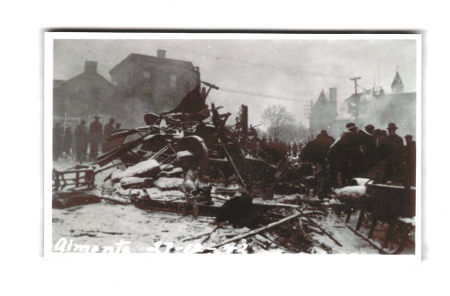The weather on that evening, Sunday, December 27th 1942 was miserable. The Ottawa Valley was hit with a mix of snow, sleet, and freezing rain as the local 550 train made its way from Petawawa toward Ottawa. Mist rising from the rivers and the blackout, necessitated by the war added to the darkness.
By contrast, it was a beautiful Saturday afternoon, February 22nd, 2025 when almost 60 of us gathered at the Main Branch of the Ottawa Public Library to hear Jamie Bramburger relate the tragic story of the wreck of train 550 at Almonte on the night of December 27th, 1942. Jamie Bramburger ;was trained as a broadcast journalist and spent 14 years working as a news director, assignment editor, and news reporter in radio and television, before joining Algonquin College’s Pembroke Campus as its Manager of Community and Student Affairs. Jamie is the author of two books, Go Kings Go - A Century of Pembroke Lumber Kings Hockey, and Sudden Impact -The Almonte Train Wreck of 1942.
Jamie told us that the 550 had left Petawawa at 5:35 that afternoon, pulled by a locomotive known by its crews as the “Cantankerous Old Hog”, which had a boiler leak, further diminishing its efficiency. Being at the end of the Christmas holiday, it was pulling 10 wooden coaches, about 3 times its normal length, mainly women and families returning to their government work in Ottawa. It was a “milk run”, stopping at every station along the way for more passengers, arriving in Almonte at 8:32pm to a station crowded with well-wishers saying farewell to their own family members and guests. The sound of Christmas carols filled the night air.
A troop train with13 metal coacheshad left Chalk River shortly after the departure of 550 from Petawawa, Jamie explained, that it had been instructed to get to Ottawa as quickly as possible. Trains travelling along the same track in the same direction were protected from collision by a 20 minute block. This was a forced stop at each station by the following train to ensure that there was a 20 minute gap between the time it left and the preceding train had left. This was enforced at each station along the route that was staffed, and the procedure was followed at Renfrew and again at Arnprior. In Almonte, at 8:38, as the 550 was preparing to leave, the troop train slammed into the back of 550, totally destroying the last 2 coaches and finally coming to rest halfway into the 3rd last coach.
Jamie did his best to describe to us the horror of the scene that unfolded. Many were killed instantly, some were seriously injured, some were thrown from the train and were not found until the next day. Ultimately 38 were killed or died within a few days while over 150 others were injured. Almonte responded heroically, the townsfolk flocking to the crash site to lend assistance, driving their cars to the site to use their headlights to illuminate the wreck and surrounding area. The nearby O’Brien Theatre was turned into a casualty clearing station while the Town Hall became a temporary morgue. The small Rosamond Memorial Hospital and the town’s 3 doctors and few nurses were overwhelmed but worked without stop to treat the injured as other medical help was brought in from the surrounding towns and finally a hospital train arrived from Ottawa.
The soldiers from the troop train also swarmed to action, bringing their blankets and their first aid kits. Though there were no casualties on the troop train, 8 members of the military were killed on 550, making their way back to Ottawa.
Jamie shared with us the stories, accompanied by photos, of a number of the individuals that were involved in the crash. One story was of Jean O’Brien, who survived with serious injuries only to discover that her husband, Harold, and 2 year old son, Jackie, had perished. Another highlighted a nursing Sister, Anne Thorpe, who tore pieces from her own clothing to treat the wounded, took the hospital train back to Ottawa, then went immediately to work for her regular hospital shift. There was also the story of Thomas Lynn, who suffered a serious leg injury in the crash that prevented him from serving in the Armed Forces. He kept the ticket of his trip in his wallet for the rest of his life, unbeknownst to his family. We invite you to check out the filmed presentation to obtain the details of these and many others stories through the link toward the end of this article. Jamie pointed out that the impact of the injuries and of the lives lost lasted throughout the lifetimes of those who survived and continues, through the 80 years that have now passed. It has become an integral part of these families’ history.
Despite the scale of the tragedy, the wreckage was quickly cleared and the rail line was open again the next day. As Jamie explained, there was a war on.
Officials sought to understand the cause of the disaster and Jamie told us that there were 5 separate inquiries. One was conducted by the Canadian Pacific Railway (CPR), one by Canada’s Transportation Commission, one by the Ontario Provincial Police, one by the military and finally there was a Coroner’s Inquest. Using Freedom of Information requests, Jamie was able to obtain details of 4 of these, which included interviews with all of the crew members of both trains. No information seems to have survived from the investigation conducted by the military. The Coroner’s Inquest, held on January 7, 1943, from a jury of 5 business men from Almonte, cleared the crews of both trains of any responsibility for the accident, concluding that the CPR was responsible. Their justification being that the CPR had failed to staff the station in Pakenham and so the troop train was not held at that station to provide the mandatory 20 minute block. Canada’s Transportation Commission disagreed, finding fault with both crews. The Commission found that the troop train was travelling too fast and was not under control of its engineer, Lorne Richardson, while also citing the crew of 550 for not lighting a flare at the back of their train.
There was one more death. Jamie told us about John Howard, who was the conductor on the troop train, and so the one in charge. He had been in the caboose at the time of the crash but had worked tirelessly after. Just prior to the inquest he took his own life.
We were fortunate to be joined in the audience by a daughter of one of the survivors, who generously shared her family’s story. Her mother was thrown from the wreck and not found until the following day. Her injuries were extensive and she was not expected to live, but did so, spending a year in the hospital recovering. She was told that she would not be able to have children, but went on to have 6, and lived into her late 70s, though still suffering from the effects of the crash.
In 1978, the railway station in Almonte was torn down and has since been replaced by the Public Library. In 2012, the tracks themselves were removed. In 2002 two granite markers were erected by the North Lanark Historical Society at the corner of Mill Street and Bridge Street to commemorate the accident.
Jamie’s session was filmed by HSO volunteer Jenny Armina and can be viewed in full on the HSO YouTube channel.
An article by Jamie can be found on the Historical Society of Ottawa blog at: Sudden Impact - The Story of the 1942 Almonte Train Wreck - The Historical Society of Ottawa
We would also encourage you to try and get a copy of Jamie’s book, Sudden Impact -The Almonte Train Wreck of 1942.
Note: It was with great sadness that we learned of the passing of Jamie Bramburger, only weeks after being honoured to have Jamie as guest speaker for our February HSO Speaker Series. Our thoughts remain with Jamie's family and friends, and the Algonquin College and Ottawa Valley communities in which he played such an important role.
A message from Algonquin College: https://algonquintimes.com/college-mourns-sudden-loss-of-jamie-bramburger






